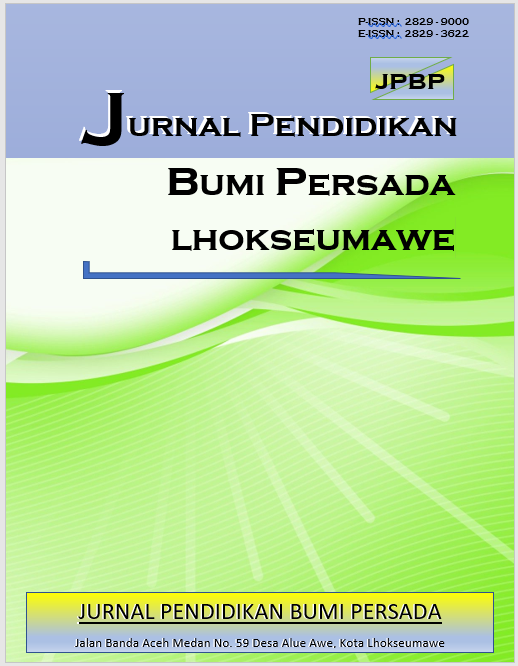CODE-SWITCHING USED BY TEACHERS: A DESCRIPTIVE ANALYSIS AT KIDDOS KINDERGARTEN, BANDA ACEH, INDONESIA
Abstrak
This descriptive qualitative study investigated into the phenomenon of code-switching from English to Indonesian implemented by the teacher at Kiddos English School, aiming to uncover its various types, functions, and underlying reasons. Drawing on the theoretical frameworks of Hudson (1980), Wardhaugh (2006), Hoffman (1991), and Gumpers (1982), observations were conducted to identify six distinct types of code-switching, while interviews explored the teachers' motivations for employing this linguistic strategy. The findings highlighted that Conversational code-switching emerged as the most frequently observed type (50.02%), indicating its prevalence in the instructional context. Conversely, Metaphorical code-switching was identified as the least common type (2.77%). In terms of functions, Reiteration emerged as the predominant function (70.25%), suggesting its role in reinforcing or clarifying information for students. In contrast, Addressee Specification was the least frequently observed function (0.83%). The reasons driving the use of code-switching were multifaceted and included the necessity to discuss specific topics, quote external sources, emphasize certain points, utilize interjections, clarify through repetition, ensure comprehension, and express group identity. Importantly, the overarching aim of code-switching among teachers was to facilitate student learning by enhancing comprehension and engagement with the material. Overall, teachers primarily utilized conversational code-switching to restate messages, aiming to aid student comprehension.
Referensi
Abduh, A., & Rosmaladewi, R. (2019). Language policy, identity, and bilingual education in Indonesia: a historical overview. XLinguae. https://doi.org/10.18355/xl.2019.12.01.17.
Afridayanti,. (2012). The Analysis of Code Switching Used by Bilingual School Teachers on Second Grade at SMPN 1 Banda Aceh. (Script). Universitas Syiah Kuala. Banda Aceh.
Ahmad, B. H. & Jusoff, K. (2009). Teachers’ code-switching in classroom instructions for low English proficient learners. English Language Teaching, 2(2), 49-55.
Candilas, K., Villanueva, I., Taglinao, E., & Villarta, K. (2023). A Phenomenological Inquiry of Code-Switching Among College Students. AsiaCALL Online Journal. https://doi.org/10.54855/acoj.231418.
Chen, X., Xiao, J., & Liu, Y. (2023). The Application of Code-switching in Chinese College Students Second Language Acquisition. Communications in Humanities Research. https://doi.org/10.54254/2753-7064/3/2022748.
Flyman-Mattson, A., & Burenhult, N. (1999). Code-Switching in Second Language Teaching of French. Lund University, Dept. of Linguistics 1 Working Papers 47, 59–72.
Gumperz, J.J. (1982). Discourse strategies. Cambridge: Cambridge University Press.
Hoffman, Carolette. (1991). An Introduction to Bilingualism. New York: Longman
Hudson, Ricard Anthony. (1980). Sociolinguistic. Cambridge: Cambridge University Press.
Hymes, D. (1962). The ethnography of speaking. In T. Gladvin and W. C
Mahmud, Y. (2020). Conceptualizing Bilingual Education Programs through CLIL and Genre-Based Approach: An Indonesian Context. , 4, 62-74. https://doi.org/10.29408/veles.v4i1.2005.
Marasigan, E. (1983). Code-switching & Code-mixing in Multilingual Societies. Singapore: Singapore University Press for SEAMEO Regional Language Centre.
Markhamah, L., Kardena, A., & Bukittinggi, I. (2023). Code Switching in English Teaching Learning Processes of English as a Foreign Language. PESHUM : Jurnal Pendidikan, Sosial dan Humaniora. https://doi.org/10.56799/peshum.v2i3.1495.
Miles, M. B., & Huberman, A. M. (1994). Qualitative data analysis: An expanded sourcebook (2nd ed.). Sage Publications, Inc.
Mubarak, M., Dewi, U., & Siregar, D. (2023). The Use Of Code-Switching By Teacher In Classroom Interaction At MAN 2 Model Medan. VISION. https://doi.org/10.30829/vis.v18i2.2242.
Santoso, T. (2006). The Benefits of bilingual education and its applications in Indonesia. Jurnal Pendidikan Penabur 5(6). Retrievied from http://www.bpkpenabur.or.id/files/Hal.42-45%20The%20Benefits.pdf.
Siregar, S. (2023). Teachers’ Code-Switching in English Language Setting. Foremost Journal. https://doi.org/10.33592/foremost.v4i1.3311.
Susanty, L., Saud, J., Munawir, A., , J., & , F. (2023). The Context of Using Code Switching between Students and Lecturers at Islamic Education Management Study Program: A Sociolinguistic Study. RETORIKA: Jurnal Ilmu Bahasa. https://doi.org/10.55637/jr.9.1.6647.93-99.
Titone, R. (1989). On the bilingual person. Canadian society for Italian Studies. Canada: Department of Modern Languages and Literatures, University of Ottawa, Ottawa, Ontario, CANADA. Retrieved from http://books.google.co.id/books?isbn=0969197969.
Wardhaugh, R. (2006). An Introduction to Sociolinguistics fourth edition. Oxford: Blackwell Publishing.
Weng, P. (2011). Code-switching as a strategy use in an EFL classroom in Taiwan. Tamkang University. Taiwan.


